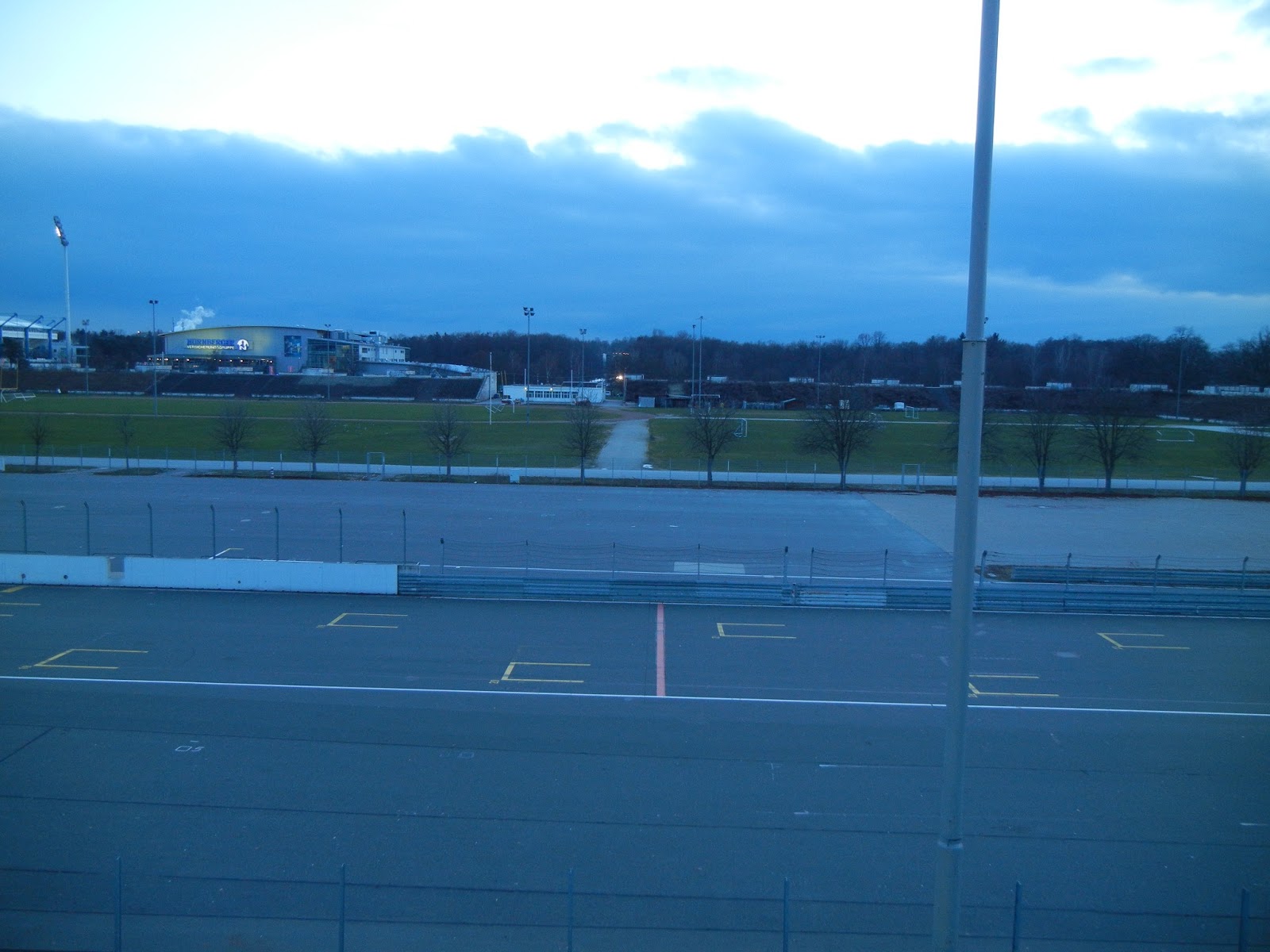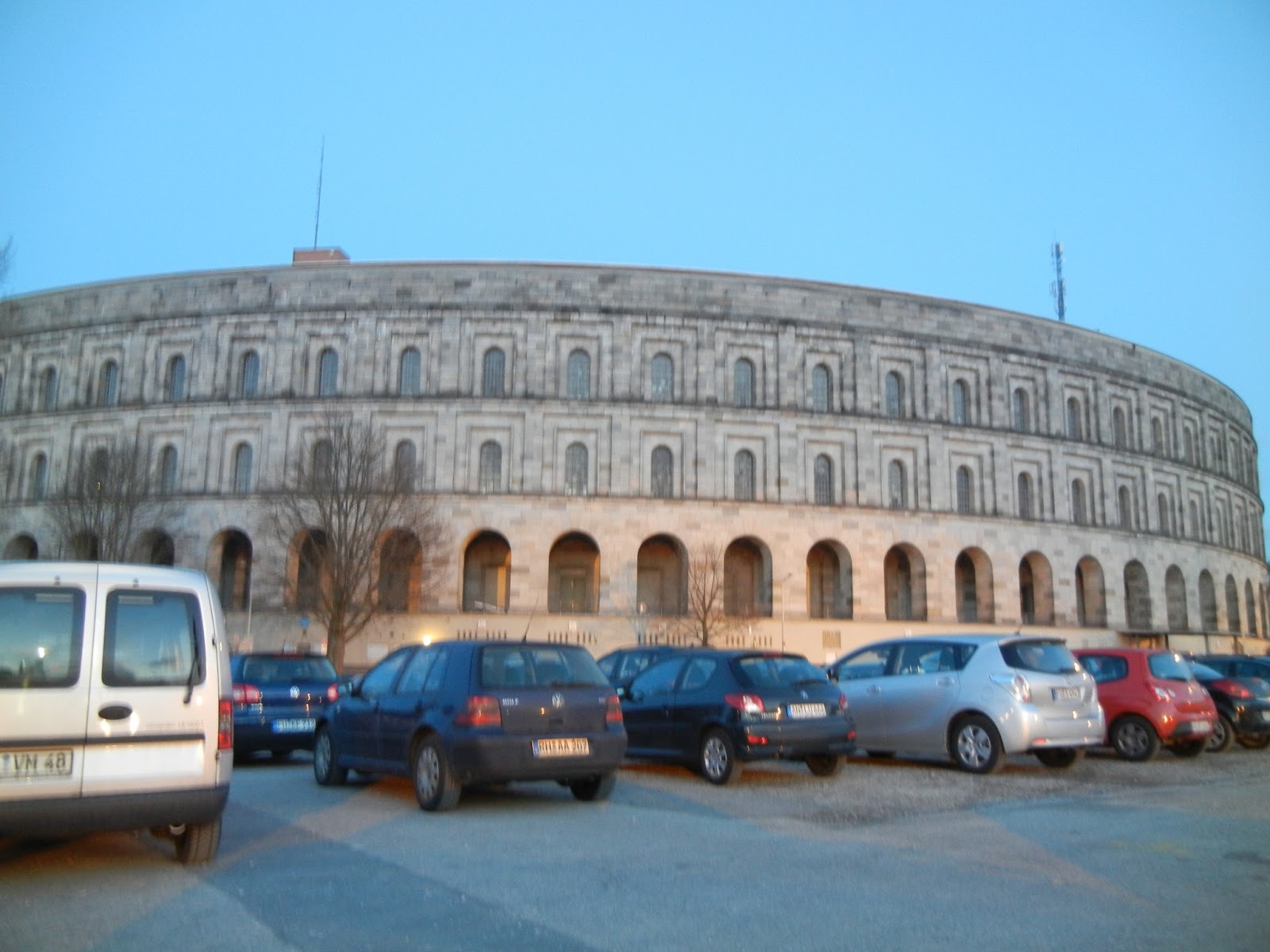I got to sleep in until 9:30am, and then was treated to a wonderful homemade french toast breakfast! I LOVE french toast! Around 11am we set off on the underground.
Nuremberg is pretty much the "Christmas Town" I would just die being here around Christmas! They are very well known for their Medieval architecture, gingerbread cookies (lebkuchen), nutcrackers, coo coo clocks, woodworking, little bratwurst, and of course, the Nazi Rallies.
You have to pass through the Old Town Wall in order to enter the city itself, but the underground goes right in there. Our first stop was to the center square where lots of vendors open shop.
I also enjoyed the nice lamp posts and the cobblestone walkways
On the side of the square you can see the Frauenkirche church. This church is located were a synagogue used to be, but under unfortunate circumstances (antisemitism before Hitler) the Jews were forced out and killed.
The most amazing, high tourist area on the square is located in the far left corner--The Beautiful Fountain (Schoner Brunnen). Since the river surrounding the area was often very dirty and polluted, this fountain was to bring clean water into the square. It also has it's own superstitisions as well. There are two rings located on the Fountain: the one facing the church and inner square is black and if you stand up and spin it three times, it is supposed to bring you fertility. The second ring is gold, spin that three times and you will get good luck!
Spinning the GOLD ring for Good luck! :)
The Black Ring for Fertility. Cherith spinning that one!

Right next to the fountain is a lovely little souvenir shop with lots of Christmas things. Walking along the street, you will find lots of great architectural buildings. Take a look!
I thought this looked like a clown!
Another Church
Me! :)
A little bit of a hike up there on the cobblestones.
After you walk back down the cobblestone walk way, take a right down a narrow set of stairs and follow the road to a well. Just beyond the well is the Tiergartnertorplatz--a giant rabbit. It's a little grotesque but it is an interpretation of a well-known painting by medieval Nuremberg artist Albrecht Durer. This guy was a big deal. He lived in the late 1400's, studied in Venice, and brought some Renaissance to Germany. He was a bit unlike European artists because he signed his work and painted things to study them. His house is located just down the road to the left and tours are given there during the day. Unfortunately, I chose not to go on the tour because none of the works in there were originals--those are all in the German National Museum.
Now we decided to walk back down the main road to the castle and explore the other half of the Old Town. Just after passing the square on your left, there is a German Gingerbread or Lebkuchen that Nuremberg is famous for. We bought a cookie and went over to the Starbucks for a drink
German Gingerbread with a chocolate coating and orange filling!
We then went back through the way we entered the square. On the left is the Holy Ghost Hospital. This hospital was donated by the rich in the 14th Century so that the poor would be taken care of.
Now you walk just a bit further down and you will find St. Lawrence Church. This was once a Catholic Church but now holds Protestant.
The facade is 260 feet tall! It also depicts key happenings in the Christian faith.
The inside of the church is seriously the most beautiful thing I have ever seen; it is breathtaking! It was free to enter so enjoy my plethora of photos! The interior of the church is all from the Catholics and has survived three major threats on its safety including the bombing of WWII.
Stain glass windows!!!!!!
This woodcraving The Annunciation is by one of the best woodcarvers Veit Stoss and was craved in 1517. It is of the angel telling Mary she is going to have baby Jesus.
So gorgeous!!
Small organ
This tabernacle tower is also quite impressive. It sits to the left of the alter and stores the leftovers from Communion. Everything is carved from stone except for Jesus at the top, which is made of wood. At the very bottom you will see the little man holding up the tower. This is the artist, Adam Kraft, who put himself into his artwork.
Because of the anticipated bombing of Germany, this tower was encased in concrete except for the top 22 feet which was destroyed when the church was hit.
Big organ!
After leaving the church, we walked out and to a small castle called the Nassauer Keller (like 5 foot door entrance!) that led to a basement medieval restaurant with real suits of armor!
After emerging from the cellar, we continued to travel to the last two stops in Old Town: The Old Granary which was built to ensure that there was enough food, but now is used as a beer hall. The second and last stop was the Craftsman's Courtyard.
The Granary
Beer!
The Frauentor Tower. It was originally built in a square shape, but was made round so that cannon balls would glance off.
I was also glad to see an Irish Pub in Germany! They have quite a few too.
After this excursion, we walked back to Cherith's house and had leftovers from dinner the night before, then took her little dog and drove the 10 minutes to the Nazi Rally Grounds. A law was passed in Germany that made it illegal for the German's to deny the not so great part of their history. But, I feel, they definitely try to hide it as much as possible--but still keep some things up. We started at the Nazi Documentation Center and walked around the museum (3 euro charge for students). The museum was very nice and they provide audio guides so that you can understand the different pieces.
They start the museum with a 7 minute film that is set to some intense music and shows what the grounds used to look like and what they look like now. They have pretty much built around the area and try to blend in the horrible history of those grounds with modern things--see pictures later. Since the museum in built inside the center, they have preserved the interior walls which I really liked.
Documentation Center
Mein Kampf
What the Rally Grounds used to look like
The Rally Grounds could hold 200,000 people
American Liberation
Documentation Center and Congress Hall
The interior of the Congress Hall
Railroad where the Jews were sent off
There is a card written with the information of each Jewish person killed. There are 1,000,000 cards and each card represents 6 more cards
The names of the concentration camps
Pillars that were beginning to be made. The Center was going to be used for parties.
Zeppelinfeld--the Rally Grounds were the Nazis gathered for their rallies. These grounds could hold 200,000 people.
These towers were originally much taller, but because of safety hazards, they had to be shortened.
What the grounds used to look like
What they look like right now. Notice why I said that they try to hide that history? The asphalt driveway and the additional buildings built there try to modernize the place.
The Podium where they gave speeches
Me standing on the Podium where Hitler stood. So weird!
Hitler stood here...
Outside architecture of the Congress Hall






































































































No comments:
Post a Comment